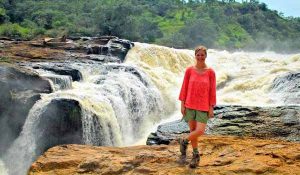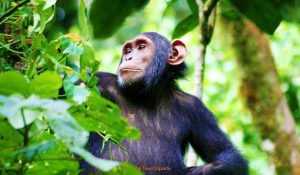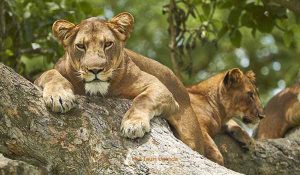The 10 Uganda National Parks | Best Safari Parks in Uganda
Uganda National Parks: Located in East Africa, Uganda is a home to 10 National Parks each offering a lifetime opportunity to tourists to discover world’s distinct attractions. The 10 Uganda National Parks range from the forest to savanna protected areas with each sheltering unique wildlife making Uganda one of the most preferred African safari destinations.
10 Uganda National Parks – Safari Parks
Bwindi Impenetrable National Park
Bwindi Impenetrable National Park is suitably lying on the Western Rift Valley/Albertine Rift Valley, Southwestern Uganda. Bwindi National Park is surrounded by three/3 districts in the Southwest; Kabale, Kisoro and Rukungiri. Boasting of a lush impenetrable forest, Bwindi Impenetrable National Park was designated as a National Park in 1991. In 1994, it was recognized as a UNESCO World Heritage Site and sits on elevation range of about 1160-2607m.

Bwindi Impenetrable National Park, one of the 10 Uganda National Parks protects a significant number of wildlife including a total of 120 species of mammals with 7 diurnal primates. It also inhabits 200 butterfly species, 360 bird species, a scenic Afro-montane forest featuring vines, ferns and shrubs, hundreds of species of trees and more.
Top Attractions in Bwindi Impenetrable National Park: There are lots of amazing attractions and activities in Bwindi including mountain gorillas/gorilla trekking, nature walks. Bwindi is composed of 6 major trails including Muzabajiro loop, Munyanga waterfall walk, Ivi River walk, Habinyanja and Buhoma-Nkuringo trail.
Birds also make up part of the amazing attractions tourists on Uganda safari should expect to sight while in Bwindi. The birds of importance worth keeping an eye in this Uganda safari park include white tailed blue flycatcher, short tailed warblers, common bulbul, African emerald cuckoo. Cultural encounters- include interacting with the Bakiga and Batwa and cycling or biking.
Read; About Bwindi Impenetrable National Park
Murchison Falls National Park
Murchison Falls National Park, a home to Murchison Falls one of the world’s powerful falls is undeniably the biggest Uganda safari park. Murchison Falls National Park is the only Uganda National Park lying in the Northwest side of the country and makes up part of the vast Murchison Falls Conservation Area (this includes Karuma Wildlife Reserve, Bugungu Wildlife, Budongo Forest and Murchison Falls NP).

Murchison Falls National Park is one of the oldest Uganda National Parks, founded in 1952 and expands up to 3840sq.kms of land area. Attractions and activities in Murchison Falls National Park; they include Murchison Falls- visit Murchison Falls National Park to witness how powerful this natural wonder is as it squeezes itself into a 7-8m narrow rock before breaking 43m then flow towards the Albert Nile.
The other main attractions and activities in Murchison Falls National Park include the Nile- Lake Albert delta, big game (buffaloes, elephants, lions and leopards), Karuma Falls, primates including chimpanzees, 451 bird species including the shoebill stork, Abyssinian ground hornbill, squacco heron, white browed sparrow weaver, goliath heron, grey crowned cranes, pia piac, malachite kingfishers, black billed barbet, red throated, blue headed coucal, African quail finch, swamp flycatcher.
Read; About Murchison Falls National Park
Mgahinga Gorilla National Park
Mgahinga Gorilla National Park is the only place in Uganda and one of the few in Africa where gold meets silver. A visit to Mgahinga National Park on Uganda safari is a great opportunity to enjoy a striking encounter with both mountain gorillas and the golden monkeys while in the wild. This is the smallest of all the 10 Uganda National Parks, straddling on 33.7sq.kms of land area.
Mgahinga Gorilla National Park lies within the Virunga Region, protecting 3 of the 8 Virunga Massifs- Sabyinyo (3645m), Gahinga volcano (3474m) and Muhabura Volcano (4127m). Mgahinga National Park top attractions include mountain gorillas, golden monkeys, Virunga Volcanoes, birds, Batwa trail, Garama caves and more.
Kibale National Park
Kibale National Park is one of the leading chimpanzee tracking destinations in Africa, protecting over 1500 chimpanzees. It is best referred to as the primate capital of the world for a reason, protecting over 13 primate species such as chimpanzees, black and white colobus monkeys, blue monkey, red tailed monkeys, grey cheeked mangabeys, baboons, red colobus monkeys and blue monkeys.

Other than primates, Kibale Forest also boasts of other interesting species of wildlife including bush pigs, duikers, buffaloes, elephants, reptiles, amphibians and more. The park is also composed of 375 bird species including 6 native birds and several Albertine rift bird species.
Kibale National Park’s interesting birds include blue breasted kingfishers, African green breasted pitta, red faced woodland warblers, blue headed sunbird, black bee-eater, little greenbul, Abyssinian ground thrush. Crater Lakes in Kasenda area make up part of the many unique attractions you should expect exploring while on Kibale National Park safari or embark on cultural tour- visit the Batoro in their local communities etc.
Kibale National Park was officially gazetted in 1993 and covers 795sq.kms, lying on elevation range of 1100-1590m. Kibale largely features a wet tropical forest, woodland and savanna grassland patches each sheltering diverse wildlife species that make it one of the amazing Uganda safari parks.
Kibale National Park is geographically set in the Western side of Uganda, 5-6 hours’ drive and from Fort Portal City, 26kms away. There are ways to access Kibale other than setting off from Kampala, there is an option of traveling from Queen Elizabeth National Park, Semuliki National Park, Rwenzori Mountains National Park, Murchison Falls National Park to Kibale National Park.
Queen Elizabeth National Park

Queen Elizabeth National Park- A True Medley of Wonders and the only home to see the tree climbing lions. Queen Elizabeth National Park is located in Western Uganda, straddling between Lake George and Lake Albert.
It was named- Queen Elizabeth National Park in 1954, taking its name from the Queen Elizabeth of England. It occupies 1978sq.kms, sheltering variety of wildlife and other unique attractions.
The major attractions in Queen Elizabeth National Park include the tree climbing lions, 620 bird species, Kazinga Channel that links Lake Albert and George. The channel protects a large population of Nile crocodiles, hippos, aquatic birds, most of which can be explored on a boat cruise.
Read; About Queen Elizabeth National Park
Mount Elgon National Park
Mount Elgon National Park is geographically lying in Eastern Uganda, a home to Mount Elgon that rises at altitude range of 4321m. The park spans on 1121sq.kms of land area and inhabits diversity of wildlife including forest elephants, bush bucks, buffaloes, birds such as white starred forest robins, black collared apalis, lammergeyer, hunters cisticola, mash widow bird, alpine chat and many more.
Other must visit attractions in Mount Elgon National Park include caves such as Chepnyalil, Kitum caves, Makingeny, Ngwarisha. For hikers, don’t miss visiting the Sipi Falls or to conquer the Wagagai peak on Mount Elgon taking different trails such Sasa, Piswa, Sipi and others.
Rwenzori Mountains National Park

Rwenzori Mountains National Park is found in Western Uganda and it is a popular mountaineering destination in Africa. Rwenzori Mountains NP is one of the biodiverse parks and in 1994, it was designated as a UNESCO Heritage site. The park occupies 1000sq.kms, hosting significant wildlife with over 60 species of mammals, 200 bird species and others.
Rwenzori Mountains National Park hosts elephants, bush bucks, giant forest hogs, red tailed monkeys, baboons, blue monkeys, leopards. Birds in Rwenzori Mountains NP include Queens turacos, Rwenzori collared birds, red faced woodland warblers, dwarf honey guide, Kivu ground thrush and more.
Semuliki National Park
Established in 1993, Semuliki National Park lies in Western Uganda, covering 220sq.kms of land area. The protected area forms an extension of the lush Ituri Forest and features Sempaya hot springs. Semuliki protects mammal species such as De Brazzas monkeys, vervet monkeys, Mona monkeys, colobus monkeys, grey cheeked monkeys, chimpanzees, baboons.
Other mammals include hippos, leopards, buffaloes, bush babies, elephants and birds to expect to sight include white crested hornbill, African peculate, orange cheeked waxbill, crested malimbe, red billed dwarf, yellow throated cuckoo, blue headed crested flycatcher.
Kidepo Valley National Park
Kidepo National Park, located in the extreme Northeast is a true wilderness paradise in Africa. The park was founded in 1962 and sits on the rugged savannas in Karamoja region, 520kms off from Kampala capital. Kidepo straddles on land area of 1442sq.kms, inhabiting 77 mammal species, 475 species of birds and in the surrounding, there are Karamojong and Ik communities.
Kidepo National Park is an important habitat to vast population of elephants, antelopes, buffaloes, lions, leopards, cheetahs, giraffes, warthogs and others. Birds in Kidepo include the Ethiopian swallow, white billed tit, African grey flycatcher, scarlet chested sunbird, red billed ox-pecker, superb starling, ostriches and more.
Lake Mburo National Park

Lake Mburo National Park is one the smallest Uganda savanna parks, located in the western part of the country. The park spans on 370sq.kms, sheltering 350 bird species, 13 lakes, leopards, zebras, giraffes, impalas, hippos, reedbucks, and more.
Lake Mburo National Park was established in 1983 and protects diversity of wildlife with interesting birds such as brown parrot, red necked spur, bare faced go away bird, white winged warblers, swampy shoebill stork, yellow throated long claw, black billed barbet, green wood hoopoe, blue napped mouse birds.
The major activities to engage in while at Lake Mburo include horseback riding, game drives, boat cruise, birding, nature walks, cultural experiences and others.
Park Entrance Fee for Uganda National Parks
Here’s a general overview of the entrance fees for various national parks in Uganda. Please note that these fees can change, so it’s always a good idea to check with the Uganda Wildlife Authority (UWA) or the park directly for the most current costs.
A table showing the current entrance fees for national parks in Uganda
| National Park | Foreign Non-Resident | Foreign Resident | East African Community (EAC) | Ugandan Citizens |
|---|---|---|---|---|
| Bwindi Impenetrable National Park | $40 | $30 | $20 | UGX 10,000 |
| Mgahinga Gorilla National Park | $40 | $30 | $20 | UGX 10,000 |
| Queen Elizabeth National Park | $40 | $30 | $20 | UGX 20,000 |
| Murchison Falls National Park | $40 | $30 | $20 | UGX 20,000 |
| Kibale National Park | $40 | $30 | $20 | UGX 20,000 |
| Rwenzori Mountains National Park | $40 | $30 | $20 | UGX 20,000 |
| Semuliki National Park | $40 | $30 | $20 | UGX 20,000 |
| Lake Mburo National Park | $40 | $30 | $20 | UGX 20,000 |
Notes:
- Foreign Non-Resident: Generally refers to visitors from countries outside East Africa.
- Foreign Resident: Refers to expatriates and residents of East African countries.
- East African Community (EAC): Residents from Kenya, Tanzania, Rwanda, Burundi, and South Sudan.
- Ugandan Citizens: Local residents of Uganda.
These fees cover general entry into the park but do not include special permits for activities such as gorilla trekking, chimpanzee tracking, or other specific tours. For the most up-to-date information and specific details, it’s always a good idea to check with the Uganda Wildlife Authority or the relevant park authorities.
Best Time to Visit Uganda National Park
The best time to visit Uganda’s national parks largely depends on what you want to experience, but generally, the most favorable times are during the dry seasons which range from December to February and June to August.
December to February dry season is considered the short dry season. It’s a great time for gorilla trekking in Bwindi Impenetrable National Park and Mgahinga Gorilla National Park, as the trails are less muddy, and wildlife viewing is easier.
June to August dry season is the long dry season, and it’s also a peak time for tourism. Wildlife viewing is excellent in national parks like Queen Elizabeth National Park and Murchison Falls National Park, and the weather is more predictable.
However, one may as well wish to visit during the wet seasons which range from March to May and September to November because of the numerous benefits that come with them:
Wet season of March to May is the long rainy season, characterized by heavy rains and muddy conditions, which can make travel and trekking more challenging. However, the landscape is lush and green, and there are fewer tourists.
September to November is the short rainy season. While it might rain occasionally, it’s generally less intense than the long rains, and you might find good deals on accommodations and fewer crowds.
For specific activities like gorilla tracking or chimpanzee trekking, the dry seasons are preferable due to better trail conditions. For bird watching, the wet seasons are ideal as many species are more active and migratory birds are present.
